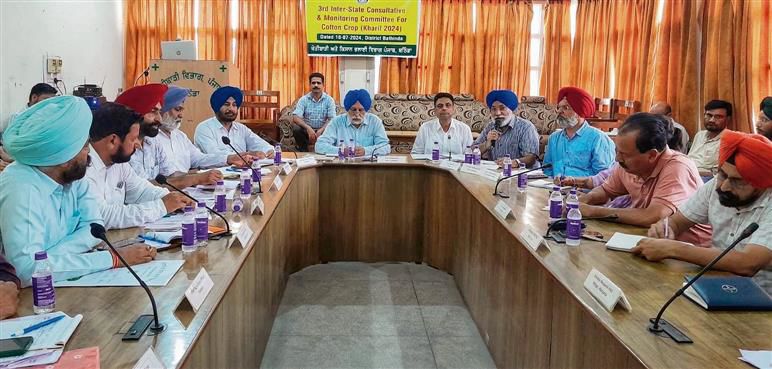Focus on key issues, strategies in cultivation at interstate meet on cotton
Ludhiana, July 19
An Interstate Consultative and Monitoring Committee meeting on cotton was convened at Kheti Bhawan in Bathinda, under the chairmanship of the Vice-Chancellor of Punjab Agricultural University (PAU), Ludhiana, Dr Satbir Singh Gosal.
Experts from different PAU departments participated in the meeting, including Dr RK Raheja, Cane Commissioner, Department of Agriculture and Farmers Welfare; scientists from PAU Regional Research Stations in Bathinda, Faridkot, and Abohar; the Central Institute of Cotton Research Institute, Sirsa; Chaudhary Charan Singh, Haryana Agricultural University, Hisar; FASC and KVK units in Bathinda, Mansa, Sri Muktsar Sahib, and Abohar; and Chief Agricultural Officers (CAOs) from various districts.
Highlighting the declining cotton acreage in Punjab and across South and Central India, Dr SS Gosal spoke about decreased productivity and problems with the minimum support price. He stressed the importance of regular monitoring and the use of recommended insecticides for managing whitefly and pink bollworm infestations in cotton.
The Cane Commissioner at the Punjab Department of Agriculture and Farmers Welfare, Dr RK Raheja, expressed concern over the reduced area for cotton cultivation. He emphasised the need for CAOs to remain vigilant and urge farmers to spray necessary pesticides for whitefly management. The CAOs from the cotton belt presented updates on insect pests, training camps, surveillance reports, and canal water availability in their respective districts.
The Principal Entomologist at PAU, Dr Vijay Kumar, presented a detailed status report on whitefly, pink bollworm, and leaf curl disease in the Bathinda, Mansa, Fazilka, and Faridkot districts. He urged farmers, especially in Abohar, to be vigilant against whitefly attacks and outlined a management strategy. He said there were no pink bollworm incidences in Mansa and Bathinda districts.
The Head of CICR, Sirsa, Dr Rishi Kumar, spoke about management strategies for addressing pest multiplication and higher pink bollworm infestation in water-stressed cotton fields.
Dr Anil Jakhar from HAU, Hisar, reported a 4 per cent pink bollworm infestation rate in Haryana, particularly in fields with last year’s cotton sticks, and noted a low incidence of whitefly.
Dr Ajmer Singh Dhatt spoke about the role of crop diversification and the necessity of managing pink bollworm efficiently. Dr MS Bhullar highlighted the importance of nutrient management and regular whitefly monitoring, advocating for more farmer training camps.









